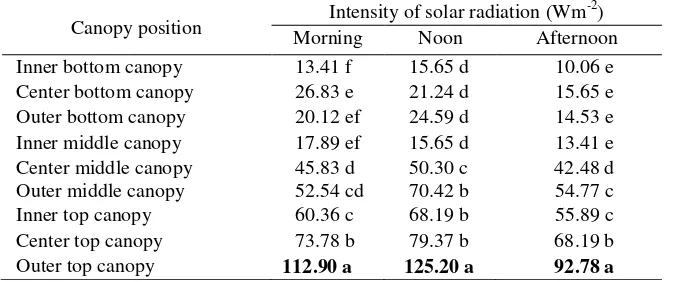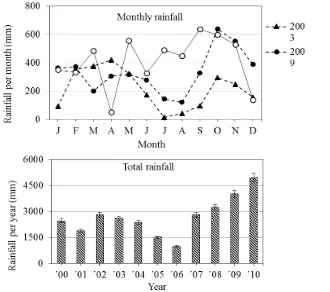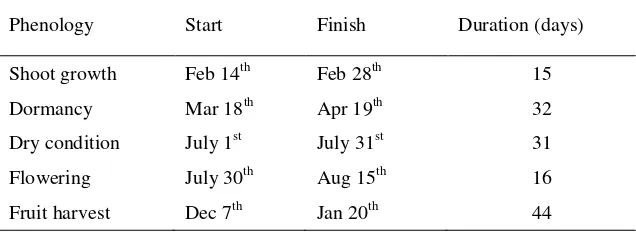1
FLOWERING PHENOLOGY OF MANGOSTEEN (Garcinia mangostanaL.) IN INDONESIA
Eko Setiawan1
1
Faculty of Agriculture, University of Trunojoyo Madura
Abstrak: The aim of the present study was to investigate the phenological characteristics of mangosteen and among-individual variation in flowering phenology at Bogor, Indonesia.Trees tend to flower after vegetative growth flushes and especially after dry weather. The dry period required to induce flowering in mangosteen. The fruiting season in the Bogor is from latest July to middle August. Bud stage to anthesis takes 19 days. Fruit development takes 115-140 days from anthesis. Fruits fast growth at 2-10 weeks after anthesis. After 13 weeks the growth of fruits is stop. Harvested period 44 days are from December 7 and latest in January 20. Fruits ripen over a 16-20 week period and picking is done by hand every 2-3 days. Generally, the fruits of mangosteen take 5 to 6 months to mature from fruit set. The pattern of fruit growth follows a sigmoid curve. In Bogor, mangosteen tree 25 years old, the fruit production is average of 50-100 fruits per tree. The fruit production is depending from canopy size. The yield varies from tree to tree and from season to season.
Keywords: anthesis, flower, fruit, Mangosteen, phenology
INTRODUCTION
Mangosteen(Garcinia mangostana L.) plant is a tropical evergreen tree, believed to have originated in the Sunda Islands and the Moluccas (Misra etal., 2009). Mangosteen the family Guttiferae is a fruit tree of the humid tropics native to the South East Asia,ranging from the southern part of Thailand andpeninsular Malaysia to Indonesia and to some partsof the Philippines (Richards, 1990).Fruit orchards in Indonesia are generally found in villages and containseveral fruit species. The fruits possess a sweetpulp which is eaten fresh, but also used in processed form. It is grown inother parts of the tropics and is one of the most praised tropical fruits.
The producing countries show several climatic regimes, and so theproduction seasons for mangosteen in these countries show some distinctdifferences. Nakasone and Paull (1998) Malaysia, Indonesia, Philippines, Thailand andVietnam generally have similar production seasons with fruits available fromMay to January.In the South East Asia region inSeptember and October, mangosteen may not be available in the marketbecause this is the end of the seasons of Thailand, Malaysia and Indonesia.The Philippine crop occurs at a time when Thai, Malaysian and Indonesiaproduction is low since its production season is later. Thus, during thisperiod, there is a window of opportunity for the Philippine mangosteen fruitsto become available in August to November (Osman and Milan, 2006). The aim of the present study was to investigate the phenological characteristics of mangosteen and among-individual variation in flowering phenology.
METHODS
2
sectors (positions in the canopy). Means were compared using Duncan’s Multiple Range Test. All statistical tests were carried out using SPSS version 16.0 (IBM SPSS Inc., Chicago) and differences with p-values less than 0.05 were considered significant.
RESULT AND DISCUSSION
Intensity Solar Radiation
Plant productivity associated with the process of plant photosynthesis. The active part photosynthesis will have more high-carbohydrate compared with the less active as in the leaves in the shadow. To find out the measurements performed on photosynthesis solar radiation intensity. The intensity of solar radiation measured at the time of fruit diameter of approximately 25 mm or the age of 8 weeks after the shoot that is broken in the first week of November 2003. Measurements made at the time of the solar radiation intensity, field conditions in the orchard area bright and not shadow by clouds. Results showed that observation on the position outer top canopy the intensity of radiation solar most high, especially in the afternoon about 125.20 Wm-2. Table 1 indicate that the radiation intensity occurs the lowest at position inner bottom canopy; center bottom canopy; outer bottom canopy; and inner middle canopy each with a value between 10.06 - 26.83 Wm-2. The solar had high radiation intensity in the noon and the lowest in the afternoon.
Table 1: The Average Intensity Of Solar Radiation Across Positions In The Canopy Position
Canopy position Intensity of solar radiation (Wm
Means with the same letter within the same column are not significantly different at 5% level (p<0.05). Rainfall
Indonesia has a tropical monsoon climate. The climate shows a distinct seasonal pattern of rainfall. Bogor area has the high rainfall average above 300 mm per month. The pattern of rainfall in Bogor area is almost same every year with the heavy rainfall period was occurred between October and December, then rainfall gradually decrease at the end of December until June (Fig. 1). Drying period occurred from July to August (case 2003 and 2009), followed by the flowering period from September to October. In 2010, however, the phenological pattern of mangosteen trees (Table 2) was changed markedly owing to irregular rainfall (Fig. 1). Climate in 2010 was anomalous, and a drought occurred in April inducing flowering of mangosteen in May. The pattern of monthly rainfall and dry season in 2010 was change and made effect on mangosteen flowering. There was an increasing trend in yearly rainfall during 2006 to 2010 (Fig. 1). The annual rainfall was 2808, 3240, 4014, and 4944 mm during from 2007 to 2010, respectively.
Temperature And Relative Humidity
Average daily maximum and minimum temperatures were ranged from 29.6 to 32.8 °C and from 21.2 to 22.7 °C, respectively (Fig. 3). Maximum temperature was high in June to September. Bogor district is a tropical temperature type remains relatively constant throughout the year and seasonal variations are dominated by precipitation.
3
every month, except in January was highest and during August to September was lowest. Whereas RH in noon was highest in January then decreased from February to December. Regardless of time, RH in August and September was lowest compared another month.
Figure 2. Seasonal Changes Of Rainfall Per Month In 2003, 2009, And 2010, And Total Rainfall Per Year In Mangosteen Orchards
4 Mangosteen Phenology
Mangosteen tree produced new vegetative shoots in February, and then fell into dormancy from March 18th to April 19th. Flowering occurred in August after the drought condition (Table 7). Fruit was growth around 13 weeks and harvested during December 2003 to January 2004. Mangosteen trees are slow to come into bearing. Trees tend to flower after vegetative growth flushes and especially after dry weather. June - July is dry seasons. The dry period required to induce flowering in mangosteen. The fruiting season in the Bogor, Indonesia is from latest July to middle August. Bud stage to anthesis takes 19 days. Fruit development takes 115-140 days from anthesis. Fruits fast growth at 2-10 weeks after anthesis. After 13 weeks the growth of fruits is stop (data not shown). Fruit should be harvested after the pericarp is light greenish yellow, with distinct irregular pink red spot over the entire fruit. Harvested period 44 days are from December 7 and latest in January 20 (Table 2). Fruits ripen over a 16-20 week period and picking is done by hand every 2-3 days. Generally, the fruits of mangosteen take 5 to 6 months to mature from fruit set. The pattern of fruit growth follows a sigmoid curve. Only the fruits that have turned purplish violet are picked. In Indonesia, mangosteen tree 25 years old, the average fruit production are 50-100 fruits per tree. The fruit production is depending from canopy size. The yield varies from tree to tree and from season to season. From observations in the field found that the fruit produced at the tip of older mature shoots can produce 3 -5 flowers in a stalk. It is known that during the mangosteen fruit is produced on a tip shoots.
Table 2: The Phenological Development Of Mangosteen Trees In 2012-2013
Phenology Start Finish Duration (days)
Shoot growth Feb 14th Feb 28th 15
5
zone, weather conditions and farm management practices, fruiting season can begin four to six weeks earlier. In mangosteen, the flowers develop at the terminal buds of young branches, solitary or paired (Te-chato, 2007; Nakasone and Paull, 1998).From Fig. 4 showed the tip can produce 3 fruits and 5 flowers in a stalk. The Fig. 5 fruit develop at both terminal and axillary buds from the node without flush new shoots. The first crop may yield 100-300 fruits per tree, and about 500 in a fully grown tree (Osman and Milan, 2006). The yield steadily increases up to 1,000-2,000 fruits per tree in the 10-20th years of cropping. In Thailand, the average yield in 1987 was 4.5t/ha. For an estimated mean weight of 75 g per fruit and 150 trees/ha, this equals 400 fruits per tree (Verheij, 1992). Trees in two small orchards in the Nilgirihills in southern India produced on average of 360 fruits per year over a period of 18 years, the best trees yielding consistently up to 500 fruits per year (Verheij, 1992). Application paclobutrazol to promote fruiting twigs in the tree canopy, an average of only 20% of the total available shoots in the whole canopy flowered every year (Omran and Semiah, 2006).
References
Downton, W.J. S., W.J.R. Grant and E.K. Chacko1990. Effect of elevated carbon dioxide on the photosynthesis and early growth of mangosteen (Garcinia mangostana L. ). Scientia Hort. 44: 215-225.
Issarakraisila, M. and R. Settapakdee 2008. Effects of light intensity on leaf structure and growth of mangosteen seedlings. Acta Hort. 787: 289-292.
Krishnamurthi, S. and N. V. M. Rao 1962. Mangosteen deserves wider attention. Indian Hort.7(1): 3-8. Malip, M. and M. Masri 2006. Establishment of protocol for carbohydrate analysis and monitoring seasonal
variations between carbohydrates and nitrogen levels in Garcinia mangostana (Mangosteen). Acta Hort. 727: 569-575.
Misra, H.,B.K. Dwivedi, D. Mehta, B.K. Mehta, and D.C. Jain 2009. Development and validation of high performance thin-layer chromatographic method for determination of α-Mangostin in fruit pericarp of mangosteen plant (Garcinia mangostana L.) using ultraviolet – visible detection. Rec. Nat. Prod. 3 (4):178-186.
Nakasone, H. Y. and R. E. Paull 1998. Mangosteen. In: H. Y. Nakasone and R. E. Paull (eds.). Tropical Fruits, CAB International: 359-369.
Omran, H. and R. Semiah 2006. Effect of paclobutrazol application combined with potassium nitrate and bicomine spray on flowering and fruiting of mangosteen (Garcinia mangostana L.). Acta Hort. 727: 151-154.
Osman, M., and A.R. Milan2006. Mangosteen-Garcinia mangostana. Southampton Centre for Underutilised Crops,University of Southampton, UK.
Richards, N. J. 1990. Studies in Garcinia, dioecious tropical forest trees, the origin of the mangosteen (Garcinia mangostana L.).Bot. J. of the Linnean Society.103: 301-308.
Setiawan, E., R. Poerwantoand S. Susanto2005. Produktivitas dan kualitas buah mangis pada berbagai posisi cabang dalam tajuk. J. Habitat 17 (3): 159-174. *
Setiawan, E., and R. Poerwanto2008. Produktivitas dan kualitas buah mangis (Garcinia mangostana L.) di Purwakarta. J. Agrovigor 1 (1): 12-20.*
Te-chato, S. 2007. Floral and fruit morphology of some species in Garcinia spp. Songklanakarin J. Sci. Technol. 29(2): 245-252.
Te-chato, S. and M. Lim 2004. Early fruit setting from tissue culture-derived mangosteen tree. Songklanakarin J. Sci. Technol. 26(4): 447-453.
Verheij, E.W.M. 1992.Garcinia mangostana. In: E. W. M. Verheij and R. E. Coronel (eds.). Edible fruits and nuts. PROSEA No. 2, Bogor, Indonesia. p: 175-181.
Weibel, J., D. Eamms, E.K. Chacko, W.J.S. Downton and P. Ludders 1993. Gas exchange characteristics of mangosteen (Garcinia mangostana L.) leaves. Tree Physiol.13: 55-69..


